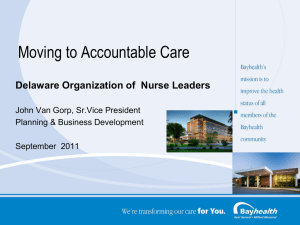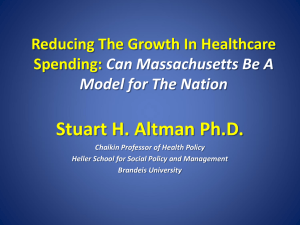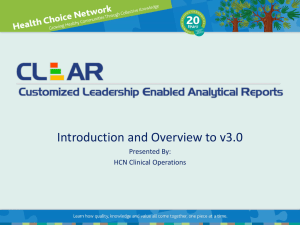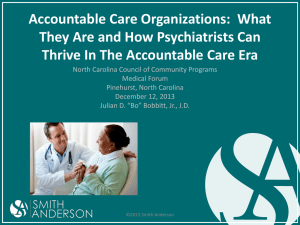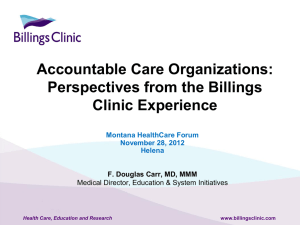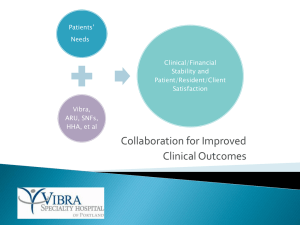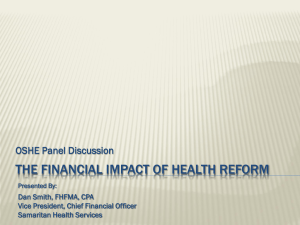The Transformers: ACO*s, Bundled Payments and Implications for
advertisement
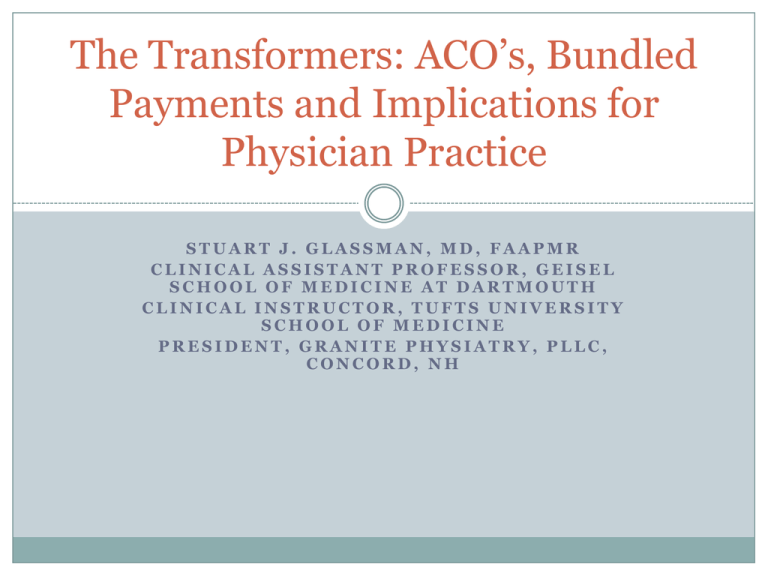
The Transformers: ACO’s, Bundled Payments and Implications for Physician Practice STUART J. GLASSMAN, MD, FAAPMR CLINICAL ASSISTANT PROFESSOR, GEISEL SCHOOL OF MEDICINE AT DARTMOUTH CLINICAL INSTRUCTOR, TUFTS UNIVERSITY SCHOOL OF MEDICINE PRESIDENT, GRANITE PHYSIATRY, PLLC, CONCORD, NH Financial Disclosure Slide Nothing to Disclose Concord Hospital/Capitol Region Health Care (Concord, NH) New CEO (Robert Steigmeyer) came from Geisinger Community Medical Center Non-profit, Level 3 Trauma Center, 295 Beds Dartmouth Hitchcock Medical Center/Geisel School of Medicine (Lebanon, NH) Level 1 Trauma Center, 396 beds CEO/President—Dr. James Weinstein (Orthopedics/Spine Care) Health System/Clinics serve 1.5 million population in NH and Vermont Accountable Care Organizations What's an ACO?--Accountable Care Organizations (ACOs) are groups of doctors, hospitals, and other health care providers, who come together voluntarily to give coordinated high quality care to their Medicare patients (www.cms.gov) Incentive payments for cost-effective healthcare outcomes ACO Categories Medicare Shared Savings Program—a program that helps a Medicare fee-for-service program providers become an ACO Advance Payment ACO Model—a supplementary incentive program for selected participants in the Shared Savings Program Pioneer ACO Model—a program designed for early adopters of coordinated care ACO’s must manage 5,000 Medicare beneficiaries for at least 3 years (Obamacare) ACO Data 2014 Currently over 600 ACO’s in the United States (CMS/government contracts, private commercial ACO’s) Over 20 million lives covered-www.leavittpartners.com CMS indicates over $372 million in shared savings for ACO programs, with improvements in quality data reporting ACO penetration map: Business Issues in Health Care Delivery Systems Bundled Payments for Care Improvement Initiative (BPCI) Announced by CMS Jan. 31, 2013 Organizations will enter into payment arrangements that include financial and performance accountability for episodes of care BCPI (cont.) BCPI Locations: 4 Models of Bundled Payments Model 1: Retrospective Acute Care Hospital Stay Only Under Model 1, the episode of care is defined as the inpatient stay in the acute care hospital. Medicare will pay the hospital a discounted amount based on the payment rates established under the Inpatient Prospective Payment System used in the original Medicare program. Medicare will continue to pay physicians separately for their services under the Medicare Physician Fee Schedule.. Bundled Payment Model 2 Model 2: Retrospective Acute Care Hospital Stay plus Post-Acute Care In Model 2, the episode of care will include the inpatient stay in the acute care hospital and all related services during the episode. The episode will end either 30, 60, or 90 days after hospital discharge. Participants can select up to 48 different clinical condition episodes. Bundled Payment Model 3 Model 3: Retrospective Post-Acute Care Only For Model 3, the episode of care will be triggered by an acute care hospital stay and will BEGIN at initiation of post-acute care services with a participating skilled nursing facility, inpatient rehabilitation facility, long-term care hospital or home health agency. The post-acute care services included in the episode must begin within 30 days of discharge from the inpatient stay and will end either a minimum of 30, 60, or 90 days after the initiation of the episode. Participants can select up to 48 different clinical condition episodes. Bundled Payment Model 4 Model 4: Acute Care Hospital Stay Only Under Model 4, CMS will make a single, prospectively determined bundled payment to the hospital that would encompass all services furnished during the inpatient stay by the hospital, physicians, and other practitioners. Physicians and other practitioners will submit “no-pay” claims to Medicare and will be paid by the hospital out of the bundled payment. Related readmissions for 30 days after hospital discharge will be included in the bundled payment amount. Participants can select up to 48 different clinical condition episodes. Triple Aim (cont.) Has 3 simultaneous areas of focus: 1. Improving the health of populations 2. Improving the patient experience of care (including quality and satisfaction) 3. Reducing the per capita cost of health care Emphasis on evidence-based medicine outcomes and comparative scientific research for healthcare decisions Triple Aim (cont.) Patient Centered Medical Home Patient-Centered Medical Home Recognition The patient-centered medical home—one of modern health care’s most important innovations—is a model of care that emphasizes care coordination and communication to transform primary care into “what patients want it to be.” NCQA Patient-Centered Medical Home (PCMH) Recognition is the most widely-adopted model for transforming primary care practices into medical homes. Clinicians, insurers, purchasers, consumer groups and others know the patient-centered medical home is a proven alternative to the nation’s costly, fragmented delivery system. Research confirms that medical homes can lead to higher quality and lower costs, and can improve patient and provider experiences of care PCMH (cont.) Safety Net PCMH Model Accountable Care Organizations in NH (2013) Pioneer ACO—Dartmouth Hitchcock ACO (NH/VT) Granite Healthcare Network/Cigna North Country ACO (Littleton, NH) New Hampshire Citizens Health Initiative Accountable Care Project Concord Elliot ACO LLC (Medicare Shared Savings Program) Northern New England Accountable Care Collaborative (Maine, NH, Vermont) ElevateHealth (Shared-Risk Arrangement between Harvard Pilgrim, DHMC and Elliot Hospital) Accountable Care Organizations in NH (2014) Lahey Clinical Performance Accountable Care Organization, LLC OneCare Vermont Accountable Care Organizations, LLC The Premier Health Care Network, LLC Winchester Community CO Circle Health Alliance, LLC New Hampshire Accountable Care Partners ACO Darmouth-Hitchcock ACO North County ACO NH Accountable Care Partners ACO Made up of 4 health systems—Concord Hospital, Elliot Health System, Southern NH Health System, Wentworth-Douglass Health System Based in Concord, NH 965 Health Care providers Cover 40,000 Medicare beneficiaries A Cautionary Tale—Where Is Rehab? NO involvement of PM&R at any leadership level in the various ACO’s Lack of involvement in Post Acute Care Committees Most physiatrists in NH are NOT employed by hospital systems—are we outside looking in? NH has 2 IRF hospitals (Concord, Salem), 3 IRF units (Manchester, Nashua, Keene), 4th to open in March 2015;various SNF level facilities (Genesis), NO LTACH No PM&R residency PM&R in the Brave New Healthcare World Post Acute Care Issues and Outcomes within ‘shared care dollars’—Variable Care costs? (IOM variation was 73%) Based on patient needs, NOT patient location (2012 Medicare post acute care costs: $62B) Functional Outcomes and Quality of Life Measures in ACO’s; 2 separate bundled payments (Acute/Post Acute Care) Variation in Post Acute Services (IOM) Physician Practice Concerns in ACO/Bundled Payment Models Upside only risk: Medicare Shared Savings, Medicare Advantage—no penalties if physician/hospital does not meet savings goal; can get bonuses if goals are met; up to 60% of savings goes to physician/hospital (one-sided risk) Downside risk—hospitals/physicians lose money if savings goals are not met (two-sided risk) Flat management fee—no bonus if savings goals are met (fee usually $3 to $5/month per patient) Public versus private payors—much more downside risk with private payor ACO; can’t tolerate losses in early years of the program Contracts may switch from one-sided to two sided after a few years Risk Versus Reward Loss of practice independence when joining an ACO Significant financial up-front costs Risk of exclusivity (usually for PCP’s) in a single ACO Balance of quality measure outcomes and cost savings generated (CMS Shared Savings program has 33 quality measures for reporting) PCP’s will likely want to have routine follow up care stay within their offices and NOT refer to specialist physicians Global Risk Contracting Becoming popular in Minnesota and Massachusetts Fixed-dollar payment amounts per patient for a specified time period (one month, one year) Large incentive on controlling costs Bundled services at the patient level, not the episode of care level May include supplemental payments based on quality measure outcomes Avoiding Specialist Exclusivity Clauses ACO exclusivity analysis focuses on whether ANY physician in a single-specialty or multispecialty group practice provides services under E&M codes for office, outpatient, home or nursing facility visits, and whether the Medicare patient sees a PCP during the applicable time period Must be careful to avoid triggering the ACO exclusivity clause, which will limit the specialist to that ACO only Specialists should encourage patients to see their PCP Consider providing services under a separate entity that bills under a separate TIN (federal tax ID number) Bundled Payments Covers payments to 2 or more providers during a single episode of care or over a specific period of time Already seen in ‘global surgery periods’ ‘Actual’ bundle—single payment to one entity (i.e. ACO) which then splits up the payment to multiple physicians ‘Virtual’ bundle—the payer makes payments to multiple providers, based on the negotiated predefined rules of the contract It IS risk-contracting; physicians should know how payments and risk adjustment factors are calculated Commercial Bundled Payments Map Bedford (NH) ASC/Harvard Pilgrim Healthcare Bundling Pilot Program Applies to routine colonoscopies—bundled payment for surgeon, anesthesiologist, facility and pathologist 44 patients participated in the first quarter of 2014 Has a built in 5% price discount Follows quality metrics from the American College of Gastroenterology (number of screening that identify polyps/cancer, type of anesthesia used) Post-Acute Care Services and the Triple Aim $62 billion spent in 2012 by Medicare on post-acute care services (11% of Medicare outlays) IOM report shows that there is a 73% variation in total Medicare spending due to utilization of PACS Hospital referral regions (HRRs) with high PACS also have the highest overall spending Quality Outcome Measures for ACO’s in 2015 will likely add in a ‘SNF 30 day “all-cause” readmission’ quality metric Improved patient outcomes do correlate with appropriate PAC utilization (SNF, IRF, Home Health, LTCH) Engagement Spectrum of ACO’s and PAC Providers Minimal—no formal engagement. ACO informs physicians of their referral patterns Conditional Collaboration—shared standards, protocols and data utilization; stay within preferred provider network Partnership—shared quality metrics and discharge data; have ‘care transition coordinators’ Financial and Data Integration—PAC provider has access to EHR; shared financial risk; share technology Full Integration—PAC providers are owned by ACO Coordinated Model of Acute and Post-Acute Care Integrated-Care markets—full array of PAC services Transitional hospital care (LTACH), short-term rehabilitation (IRF), sub-acute, skilled nursing, home health, palliative care, hospice Joint ventures for bundled payments initiative (i.e. Cleveland Clinic) Manage the transition of care for the patient, improve outcomes, decrease costs Attractive to payers, ACO’s and hospital systems Example—Kindred Healthcare Inc. (Louisville, KY; KND; annual revenue $5B; What Does the Physiatrist Bring to the ACO/Bundled Payment Table? Ability to work within a team format Focus on functional, Triple-Aim outcomes Understanding of care transitions in the post-acute world Ability to treat multiple organ system issues (brain, spine, musculoskeletal, cardiac) and disease states (diabetes, CHF, cancer, pain, obesity, asthma) Understanding of Durable Medical Equipment needs YOU MAY HAVE TO CRASH THE PARTY—the ACO leaders may not understand what we do!!
